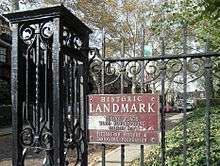Nicolson pavement

Nicolson pavement, alternatively spelled Nicholson Pavement, a.k.a. wooden block pavement or wood block pavement, is a road surface material consisting of wooden blocks pioneered by Samuel Nicolson in the mid-eighteen hundreds.[1] Wood block pavement has since become unfavorable due the drawbacks associated with its surface quality and maintenance costs.
History
.jpg)
Wood block pavement may have originated in Russia in the 14th-century, but it gained prominence in the 1820s and 1830s as a road building alternative to the irregularly surfaced cobblestone streets common during that era.[2] Wood block was also favored because stone was scarce and wood was abundant.[3] Additionally, horse traffic reportedly made less noise on wood-surfaced streets.[4] However, the drawbacks of Nicolson pavement include slippery surfaces when wet or icy,[4][5] and the tendency of the blocks to rut, decay, and heave due to moisture seeping between the blocks.[6] When treated with creosote, wood block pavement would last longer, but the creosoted pavement had a noticeable unpleasant smell.[2]
M. Gourieff introduced [to St. Petersburg] the hexagonal wooden pavement with which, in London, we are all acquainted. This, with continuous reparation, answers pretty well, taking into consideration that equality of surface seems utterly unattainable, that the knavish contractors supply blocks so rotten as to be worthless a few days after they are put down, and that the horses are continually slipping and frequently falling on the perilous highway. It is unpleasant, also, to be semi-asphyxiated each time you take your walks abroad, by the fumes of the infernal pitch-cauldrons, round which the moujik workmen gather, like witches.
Charles Dickens, A Journey Due North, 1856.
Nicolson pavement was the focus of a Supreme Court case, City of Elizabeth v. American Nicholson Pavement Co. which held that while the public use of an invention more than one year prior to the inventor's application for a patent normally causes the inventor to lose his right to a patent, there is an exception to this rule for public uses for experimental purposes.
Remnants


Remnants of Nicolson pavement still exist in several cities across the US. Incorrectly touted as the only remaining wooden street in the US, Roslyn Place in Pittsburgh, Pennsylvania, is completely paved in wooden blocks.[4][5] In addition, patches of creosoted wooden block pavement are still visible in an alley along 10th street between Olive and Locust Streets in St. Louis, Missouri,[6] and at least three other alleys in Chicago, Illinois still retain the use of wood block pavement, though some are in states of disrepair.[7] The 200 block of Camac Street in Philadelphia, Pennsylvania is also paved with wooden blocks, and it is regularly maintained having been listed in the Philadelphia Register of Historic Places.[8] Hessler Court in Cleveland, Ohio, known for its Hessler Street Fair, likewise maintains its Nicolson Pavement for historic reasons.[9]
See also
References
- ↑ "The Nicolson pavement, invented by Samuel Nicolson, of Boston, Mass.".
- 1 2 "Manhattan's First Experiments with Wooden Streets".
- ↑ "Wood Block Alleys".
- 1 2 3 "Shadyside's wooden street paves its way to greatness".
- 1 2 "I was told that there was a wooden street located in Shadyside or Squirrel Hill. Is this true? And if so, what is the history behind it?".
- 1 2 "The Creosoted Wood Block: One Step in the Evolution of St. Louis Paving".
- ↑ "Wood Block Alleys".
- ↑ "Camac Street's wooden blocks repaired".
- ↑ "Walking a Cleveland street paved completely of wood is walking a pathway to the past". Archived from the original on 2014-05-19.